| A | B |
|---|
| The study of the biological form of an organism is the study of its _______. | anatomy p.852 |
| The study of the biological function of an organism is the study of its _______. | physiology p.852 |
What type of evolution caused these unrelated animals to have the same general fusiform (tapered at both ends) body shape?, 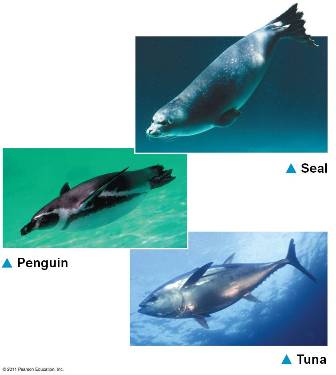 | Convergent evolution p.853,  |
The body shape of these unrelated animals is described as being _______ (tapered at both ends) due to convergent evolution.,  | fusiform p.853,  |
| The rate of exchange for nutrients, waste products, and gases is proportional to membrane _______ . | surface area p.853,  |
| The _____________ for nutrients, waste products, and gases is proportional to membrane surface area. | rate of exchange p.853,  |
| The amount of material that must be exchanged across cell membranes to sustain life is proportional to cell _______. | volume p.853,  |
| The ___________ that must be exchanged across cell membranes to sustain life is proportional to cell volume. | amount of material p.853,  |
| What are three things that must be exchanged across membranes in order to sustain life? | Nutrients, waste products, gases p.853,  |
| Name two types of body plans in multicellular animals that allow for the easy exchange of materials with the environment without the use of a circulatory system. | Sac-like (bodies with a gastrovascular cavity formed from a body wall that is only a few cells thick) and flat body shape (for example, a tapeworm or planarian) pp.853&854 |
| In larger animals with complex body plans, the evolutionary adaptation that enables sufficient exchange of materials with the environment are specialized surfaces that are extensively ______ or _______. | branched, folded p.854, 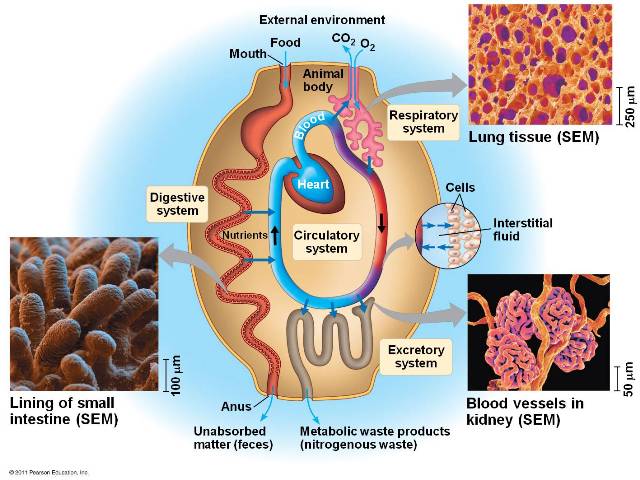 |
| The fluid that fills the spaces between cells is called ________. | interstitial fluid p.854 |
| Cells are organized into _____, groups of cells with similar appearance and common function. | tissues p.855 |
| Different types of tissues are organized into functional units called _____. | organs p.855 |
| Groups of organs that work together make up a(n) ______. | organ system p.855 |
| Which two organ systems does the pancreas belong to? | Digestive and endocrine (The pancreas produces digestive enzymes, and it produces the hormones insulin and glucagon to regulate blood sugar levels) p.855,  |
| What are the four main types of animal tissues? | Epithelial, connective, muscle, and nervous p.855,  |
| Which system's main function is food processing? | Digestive system p.855,  |
| Which system's main function is the internal distribution of materials? | Circulatory system p.855,  |
| Which system's main function is gas exchange? | Respiratory system p.855,  |
| Which two systems' main function is to defend the body against pathogens? | Immune and lymphatic system p.855,  |
| Which system's main function is to dispose of metabolic waste and regulate the osmotic balance of blood? | Excretory system p.855,  |
| Which system's main function is to create offspring? | Reproductive system p.855,  |
| Which system's main function is to coordinate body activities and maintain homeostasis by producing hormones? | Endocrine system p.855,  |
| Which system's main function is to detect and respond to stimuli? | Nervous system p.855,  |
| Which system's main function is to protect against mechanical injury, infection, dehydration, and to maintain thermoregulation? | Integumentary system p.855,  |
| Which system's main function is to provide body support, protect internal organs, and facilitate movement? | Skeletal system p.855,  |
| Which system's main function is locomotion and other movement? | Muscular system p.855,  |
| __________ tissues cover the outside of the body and line the organs and cavities within the body? | Epithelial p.856,  |
Which type of epithelial tissues is labeled #1?, 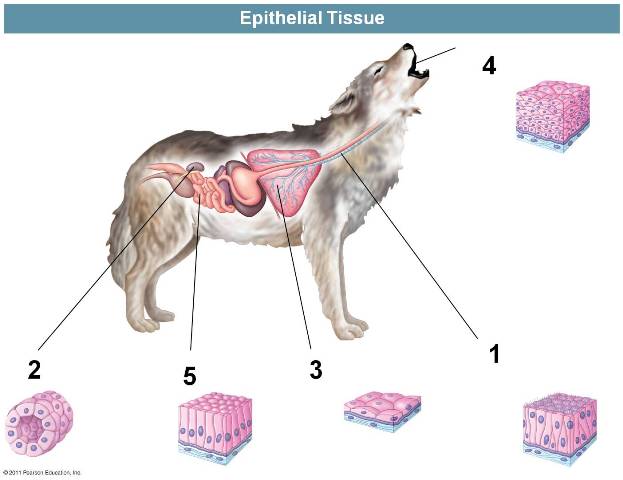 | Pseudostratified columnar epithelium p.856,  |
Which type of epithelial tissues is labeled #2?,  | Cuboidal epithelium p.856,  |
Which type of epithelial tissues is labeled #3?,  | Simple squamous epithelium p.856,  |
Which type of epithelial tissues is labeled #4?,  | Stratified squamous epithelium p.856,  |
Which type of epithelial tissues is labeled #5?,  | Simple columnar epithelium p.856,  |
| Which shape of epithelial cells specialize in secretion? | Cuboidal (Cuboidal epithelial cells makes up the epithelium of kidney tubules and many glands, including the thyroid and salivary glands) p.856,  |
| Which shape of epithelial cells specialize in active absorption or secretion? | Simple columnar (Simple columnar epithelial cells line the intestines, secreting digestive juices and absorbing nutrients) p.856,  |
| Which shape of epithelial cells specialize in the exchange of materials by diffusion? | Simple squamous (Simple squamous epithelial cells line the blood vessels and air sacs of the lungs where their thin cell structure facilitate the diffusion of nutrients and gases) p.856,  |
| Which shape of epithelial cells would form ciliated mucous membranes that line portions of respiratory tract? | Pseudostratified columnar p.856,  |
| Which shape of epithelial cells would find making up surfaces that are subject to abrasion and therefore need to be able to easily and quickly replace the cells that have sloughed off? | Stratified squamous (Stratified squamous epithelial cells are found on the outer skin as well as the linings of the mouth, anus, and vagina) p.856 |
| The ______ surface of epithelial cells is the surface that would facing either the lumen (cavity) of an organ or the outside of an organ. | apical surface p.856, 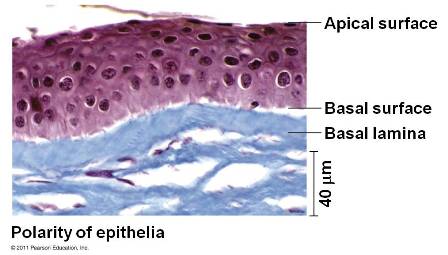 |
| The ______ surface of epithelial cells is the surface that would be attached to a dense mat of extracellular matrix that separates the epithelium from the underlying tissue. | basal surface p.856,  |
| The dense mat of extracellular matrix that separates the epithelium from the underlying tissue is called called the _______. | basal lamina p.856,  |
| ________ tissue, consisting of a sparse population of cells scattered through an extracellular matrix, holds many tissues and organs together and in place. | Connective tissue p.857,  |
| Within the matrix that holds connective tissue cells are _______ which are cells that secrete fibrous proteins, and _______ which engulf foreign particles and any cellular debris by the process of ________. | fibroblasts, macrophages, phagocytosis p.857,  |
| What are the three kinds of connective tissue fibers that make up the matrix in which connective tissue cells are embedded? | Collagenous, reticular, and elastic fibers p.857,  |
| Which type of connective tissue fiber provides strength and flexibility? | Collagenous fibers p.857,  |
| Which type of connective tissue fibers join connective tissue to adjacent tissues? | Reticular fibers p.857,  |
| Which type of connective tissue fibers help to allow connective tissue to stretch and snap back? | Elastic fibers p.857,  |
| What are the six types of connective tissue? | Loose, fibrous, bone, adipose, cartilage, and blood p.857,  |
| Which type of connective tissue binds epithelial tissue to underlying tissues and holds organs in place? | Loose connective tissue p.857,  |
| Which type of connective tissue is found in tendons and ligaments and is dense in strong but flexible collagenous fibers? | Fibrous connective tissue p.857,  |
| Which type of connective tissue consists of collagen that becomes mineralized to form hardened structures? | Bone p.857,  |
| Bone forming cells called ______ deposit a matrix of collagen that becomes mineralized by calcium, magnesium, and phosphate ions. | osteoblasts p.857,  |
| The microscopic structure of hard mammalian bone consists of repeating units called _____. Each one of these repeating units has concentric layers of mineralized matrix, which are deposited around a central canal containing blood vessels and nerves. | osteons p.857,  |
| What is found within the central canals that run through bones? | blood vessels and nerves p.857,  |
| ________ connective tissue is a specialized type of loose connective tissue that stores fat in cells embedded in the matrix of the tissue. | Adipose connective tissue p.857,  |
| What type of cells are specialized for storing fat? | Adipose cells p.867,  |
| What are three different purposes of adipose tissue? | Padding, insulation, and energy storage p.857,  |
| Which type of connective tissue has cells suspended in a liquid matrix called plasma? | Blood p.857,  |
| Blood is a connective tissue that consists of cells, platelets, and dissolved substances suspended in a liquid matrix called _____. | plasma p.857,  |
| What are the three solid substances that are found in blood? | red blood cells, white blood cells, and platelets p.857,  |
| What is the more technical name for red blood cells and what do they do? | erythrocytes, carry oxygen p.857,  |
| What is the more technical name for white blood cells and what do they do? | leukocytes, defend against pathogens p.857,  |
| ______ are a component of blood made of cell fragments that aid in blood clotting. | Platelets p.857 |
| Platelets are a component of blood made of cell fragments whose function is to _____________. | aid in blood clotting p.857 |
| Which type of connective tissue is found between the discs that separate vertebrae as well as the ends of many bones? | Cartilage p.857,  |
| Cartilage contains collagenous fibers embedded in a rubbery protein-carbohydrate complex called ______. | chondroitin sulfate p.857,  |
| What is the name of the cell that secretes the collagen and chondroitin sulfate that makes up cartilage? | chondrocytes p.857,  |
| The skeletons of many vertebrate embryos contain _____ that is replaced by bone as the embryo matures. | cartilage p.857 |
| All muscle cells consist of filaments containing the proteins ______ and _______. | actin and myosin p.858,  |
| The three types of muscle tissue in vertebrate bodies are ____, _____, and _____. | skeletal, smooth, and cardiac p.858,  |
| ______ connects muscle to bone. | tendons p.857 |
| ______ connects bone to bone. | ligaments p.857 |
| What type of muscle tissue is responsible for the voluntary movement of bones relative to each other? | skeletal muscle tissue (a.k.a. - striated muscle) p.858,  |
| What type of muscle tissue is responsible for involuntary movement such as the movement of food down the digestive tract or the constriction of blood vessels? | Smooth muscle tissue p.858,  |
| In adult mammals, building muscle increases the ____ but not the ____ of muscle fibers. | size (but not the) number p.858,  |
| What type of muscle tissue is responsible for the contraction (beating) of your heart? | cardiac muscle tissue p.858 |
| Which type of tissue is responsible for the receipt, processing, and transmission of information in the body? | Nervous tissue p.858, 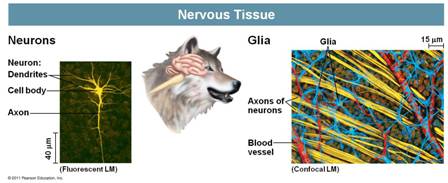 |
| The more technical name for nerve cells is ______. | neurons p.858,  |
| Nervous tissue contains ____ cells which transmit nerve impulses, as well as support cells called ____ cells. | nerve cells, glial cells (a.k.a. glia) p.858,  |
| The part of the neuron that receives information from other neurons is the ____ and _____. | cell body, dendrites p.858,  |
| The part of the neuron that transmits impulses to other neurons, muscle cells, endocrine cells and exocrine cells is the _____. | axon p.858,  |
| _____ cells help nourish, insulate, replenish, and in some cases, modulate neuron function. | Glial cells (a.k.a. - glia) p.858,  |
| Which two systems facilitate communication between various parts of the body? | Nervous and endocrine systems p.859, 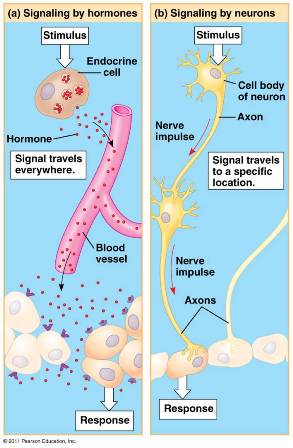 |
| The signaling molecules used for communication in the endocrine system are called ____. | hormones p.859,  |
| Which system produces signals for communication that are relatively slow acting but long-lasting and far-reaching? | Endocrine system p.859,  |
| Which system produces signals for communication that are relatively fast acting but do not endure for long? | Nervous system p.859,  |
| What are the four types of cells that can receive nerve impulses? | other neurons, muscle cells, endocrine cells, and exocrine cells p.859 |
| The _____ system is well suited for coordinating gradual changes that affect the entire body, such as growth and development, reproduction, metabolic processes, and digestion. | endocrine p.859,  |
| The _____ system is well suited for directing immediate and rapid responses to the environment, especially in controlling fast locomotion and behavior. | nervous p.859 |
| An animal is said to be a(n) ____ for a particular environmental variable if it uses internal mechanisms to control internal change in the face of external fluctuation. | regulator p.860, 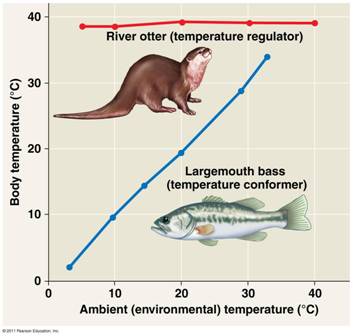 |
Which animal in the diagram below is a regulator?,  | The otter p.860,  |
Which animal in the diagram below is a conformer?,  | The bass p.860,  |
| The steady-state physiological condition of the body. | Homeostasis p.860 & G17 |
| Human bodies try to maintain homeostasis around a body temperature of _____ degrees Celsius and a blood pH of _____ | 37, 7.4 p.860 |
| Like a home heating system, an animal achieves homeostasis by maintaining a variable, such as body temperature or solute concentration, at or near a particular value called the _______. | set point p.861, 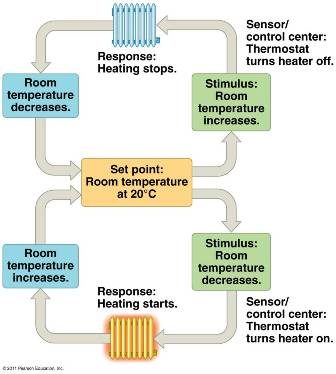 |
| What is the set point for human body temperature? | 37C p.860 |
| What is the set point for human blood pH? | 7.4 p.860 |
| Homeostasis in animals relies largely on ____ feedback. | negative p.861 |
| ______ feedback is a control mechanism amplifies rather than reduces a stimulus. | Positive p.861 |
| ______ feedback loops in animals DO NOT play a major role in homeostasis, but instead help drive processes to completion. | Positive p.861 |
| During childbirth, the pressure of the baby's head against receptors near the opening of the mother's uterus stimulates the uterus to contract. These contractions result in greater pressure against the opening of the uterus, heightening the contractions and thereby causing even greater pressure, until the baby is born. This is an example of a(n) ______ feedback loop. | positive p.861 |
| A physiological cycle of about 24 hours that persists even in the absence of external cues is called a(n) ______ rhythm. | circadian p.861 & G7, 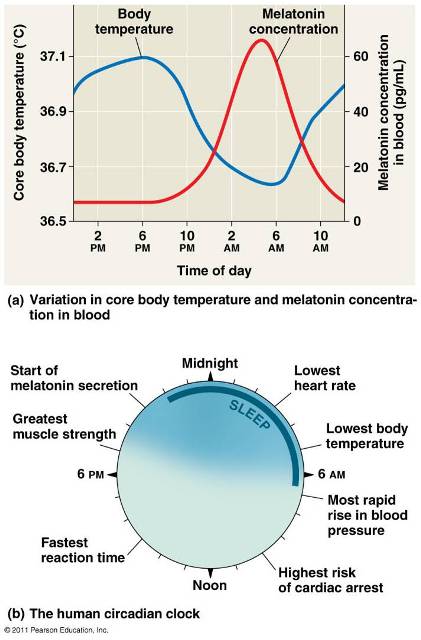 |
| One way in which the normal range of homeostasis may change is through _______, the gradual process by which an animal adjusts to changes in its external environment. | acclimitization (The production of more red blood cells when an animal or human moves to higher altitudes is an example) p.862 |
| _____ is the process by which animals maintain an internal temperature within a tolerable range. | Thermoregulation p.863 |
| What are the two sources of heat for thermoregulation? | internal metabolism and the external environment p.863 |
| Animals that are warmed mainly by heat generated by metabolism are said to be ______. | endotherms p.863 |
| Animals that are warmed mainly by heat generated by external sources are said to be ______. | ectotherms p.863 |
| Why does a bird (an endotherm) need to consume more food than a lizard (an ectotherm) of the same size? | The bird needs to use a lot of its energy to generate metabolic heat. p.863 |
| An animal whose body temperature varies with its environment is called a(n) _____. | poikilotherm (Most ectotherms are poikilotherms, but not all. For example, many ectothermic marine fishes and invertebrates inhabit waters with such stable temperatures that their body temperature varies less than that of humans and other mammals) p.863 |
| An animal whose body temperature remains relatively constant is a(n) _____. | homeotherm (Most endotherms are homeotherms, but not all. For instance, the bats and hummingbirds may periodically enter an inactive state in which they maintain a lower body temperature) p.863 |
| What are the four physical processes that any organism (and any object for that matter) uses to exchange heat? | Radiation, evaporation, convection, conduction p.864, 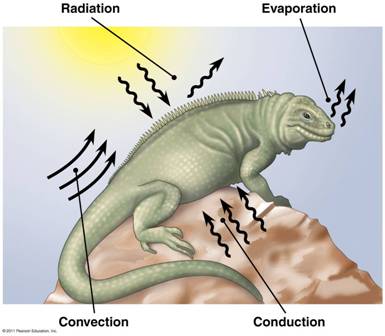 |
| _________ is the transfer of heat by the movement of air or liquid past a surface. | Convection (Technically, the movement of heat from the body's core to the extremities via blood flow is considered convection) p.864,  |
| What is the most cold-blooded animal in the world? | p. 1264,  |
| The type of heat transfer that occurs when organisms absorb heat from the sun and lose heat to the environment in the form of electromagnetic waves. | Radiation p.864,  |
| ______ is the removal fo heat from the surface of a liquid that is losing some of its molecules with the highest kinetic energy as a gas. | Evaporation p.864,  |
| _____ is the direct transfer of thermal motion (heat) between molecules of objects in contact with each other. | Conduction p.864,  |
| Name three sources of insulation that animals use to reduce the flow of heat between an animal and its environment. | Hair/fur, feathers, fat/adipose tissue p.864 |
| What is an involuntary vestigial reaction in humans designed to temporarily increase insulation in the face of a cold environment? | The formation of goose-bumps (in closely related mammals, goose-bumps raise the fur thereby trapping a thicker layer of air which increases the insulating value of the fur. Birds do this also by raising their feathers) p.864 |
| Why is the problem of maintaining body heat so much more difficult for marine mammals than terrestrial mammals, even if the environment around them is the same temperature for both types of animals? | The transfer of heat to water is 50 to 100 times faster than the transfer of heat to air (That's why you can briefly put your hand in a 400F oven without getting burned but not a 212F pot of boiling water. It's also why getting into water to stay warm on a cool day is a stupid idea) p.864 |
| In response to cold, many animals' blood vessels just below the skin undergo _______ to reduce the transfer of heat from the body core to the extremities where it can be lost to the environment. | vasoconstriction (The diameter of the superficial blood vessels decreases, thereby reducing blood flow and the heat loss to the extremities that comes with warm blood being exposed to the cold near the surface of the skin) p.864 |
| In response to heat, many animals' blood vessels just below the skin undergo _______ to increase the transfer of heat from the body core to the extremities (where heat can be transferred to the environment) by increasing blood flow to the skin. | vasodialation (Causes the diameter of the superficial blood vessels to increase, thereby increasing blood flow to the skin and also the heat that comes with the blood) p.864 |
Which concept for minimizing heat loss is being illustrated in the diagram below?, 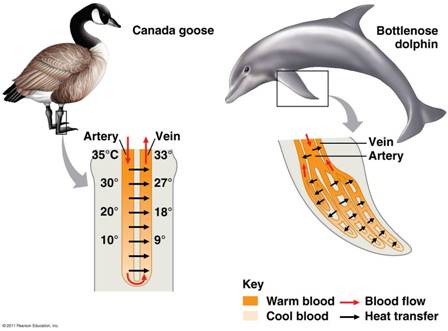 | Countercurrent heat exchange (This allows the arteries to transfer much of their heat to nearby veins instead of to the environment when the blood reaches skin surfaces) p.865,  |
| Briefly explain how evaporation leads to cooling. | Water absorbs considerable heat when it evaporates. This heat is carried away from the body surface with the water vapor. p.865 |
| The technical term for heat production is ____. | thermogenesis p.866 |
| What is the main way that endotherms adjust metabolic heat production? | shivering (The increased muscle activity required to shiver generates heat) p.866 |
| In some mammals, certain hormones can cause mitochondria to increase their metabolic activity and produce heat instead of ATP. This process is called ___. | nonshivering thermogenesis p.866 |
| What type of mammalian fat is specialized for rapid heat production? | brown fat (In human infants, about 5% of their total body mass is brown fat. It was detected in adults for this first time in 2009) p.866 |
| The sensors for thermoregulation are concentrated in a brain region called the _____. | hypothalamus p.867, 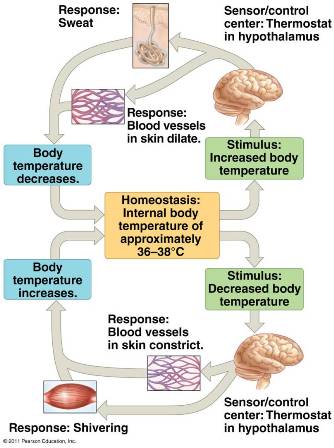 |
| The study of the overall flow and transformation of energy in an animal is called ____. | bioenergetics p.868 |
| The amount of energy an animal uses in a given unit of time is called its ______. | metabolic rate p.869 |
| The minimum metabolic rate needed to keep an animal alive, measured in endotherms as the metabolic rate of a resting, fasting, and nonstressed animal at a comfortable temperature that requires no generation or shedding of heat. | Basal metabolic rate (BMR) ** In ectotherms, metabolic rate is measured at a specific temperature because changes in environmental temperature alter body temperature and therefore metabolic rate. Instead of calling it BMR, it is called standard metabolic rate in ectotherms p.869 |
| The minimum metabolic rate needed to keep an animal alive, measured in ectotherms as the metabolic rate of a resting, nonstressed animal at a particular temperature. | Standard metabolic rate (STR) p.870 |
| Metabolic rate for most any animal remains roughly proportional to the body mass to the ___ power. This means that the energy required to maintain a certain amount of body mass is ____ proportional to the body size of the animal. | three fourths, inversely (It takes much more energy to maintain a gram of mouse cells than a gram of elephant cells because mice have a much higher metabolic rate) p.870 |
| A physiological state of decreased activity and metabolism that allows animals to save energy while avoiding difficult and dangerous conditions. | Torpor p.871 |
| Long-term torpor that is an adaptation to winter cold and food scarcity. | Hibernation p.872 |
| A type of summer hibernation in which animals enter a torpor state to survive long periods of high temperatures and scarce water supplies. | Estivation p.872 |